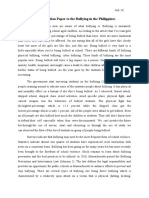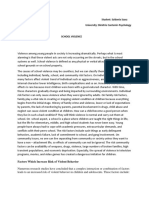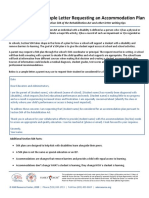BULLYING
BULLYING
Uploaded by
Seiza MwaCopyright:
Available Formats
BULLYING
BULLYING
Uploaded by
Seiza MwaCopyright
Available Formats
Share this document
Did you find this document useful?
Is this content inappropriate?
Copyright:
Available Formats
BULLYING
BULLYING
Uploaded by
Seiza MwaCopyright:
Available Formats
Lolie Shane B.
Cadiz
10 - HUMABON
BULLYING
Bullying is a very serious situation that should be taken notice. It may seem natural for some people that it
is part of a child growing up but no, it can cause mild anxiety problems to truancy to incidents of deadly violence. And
for those kids who are prone to television, films, cartoons etc. that is related to bullying and physical harassment may
adopt that kind of behavior. According to my research, ABC News state that nearly 30 percent of students are either
bullies or victims of bullying, and 160,000 kids (nationwide) stay home from school every day because of fear of bullying.
There are kinds of bullying, cyberbullying, physical bullying, verbal bullying, and social bullying.
Firstly, not long after the pandemic started, Social Media bullying or we so called “Cyberbullying.” Has one
of the questions have been asked most often over the last 18 months is whether bullying has gotten better or worse
since the start of the COVID-19 pandemic. Early on, there was a concern that cyberbullying incidents would increase as
youth were spending more time online. Additionally, many young children were perhaps given premature access to
technology with inadequate support or supervision as schools hurriedly moved to virtual educational activities and
parents simply needed to survive the extended time children had at home. On the other hand, we have long known that
bullying online is often connected to bullying at school and therefore fewer students at schools might translate to fewer
problems online.
Secondly, is “Physical Bullying” physical bullying occurs most often at school, though it can also occur on the
way to and from school and after school. Middle school is the age when bullying is most common, with almost all middle
school students being affected directly or indirectly by bullying. This is an age where young people want more to fit in
with their peers, making some students more likely to bully or condone bullying to fit in, while those who don’t fit in
stand out more as victims. Bullying can also occur in earlier grades, as well as through high school and even into
adulthood.
Thirdly, is “Verbal bullying” it is often intended to degrade or demean the target in some way. It may cause
the bully to feel powerful or in control of their target. Verbal harassment may accompany physical, sexual, or emotional
bullying or abuse. A bully might target a specific child or adult due to their weight, gender, sexuality, race, appearance,
or another reason. Verbal bullying can affect individuals in varying ways. It might cause self-esteem concerns, stress, or
mental health symptoms. Studies show that bullying can also cause post-traumatic stress disorder (PTSD).
And lastly, is “Social Bullying” it is when a person tries to hurt another person's relationships or reputation.
This harms the targeted person’s mental health because it affects their sense of belonging. Part of human nature is the
desire to feel accepted as a member of a group. Social bullying can happen online or in person. Because social bullying
can be indirect or direct, it can be hard to identify.
In conclusion, parents must give attention to their kids as they grow up, Kids learn from adults’ actions. By
treating others with kindness and respect, adults show the kids in their lives that there is no place for bullying. Even if it
seems like they are not paying attention, kids are watching how adults manage stress and conflict, as well as how they
treat their friends, colleagues, and families.
You might also like
- Where Do We Come From - Ernst MuldashevDocument293 pagesWhere Do We Come From - Ernst MuldashevAlex90% (21)
- Pediatric Nursing Clinical Objectives.Document2 pagesPediatric Nursing Clinical Objectives.edrinsne100% (5)
- Bullying EssayDocument3 pagesBullying EssayNikolai Zipagan100% (1)
- MAPEH 6 - Demo COTDocument36 pagesMAPEH 6 - Demo COTLucena GhieNo ratings yet
- Final Research Paper PDFDocument32 pagesFinal Research Paper PDFNathaniel Luis Abrera Badal50% (2)
- Bullying Definition: Back To TopDocument4 pagesBullying Definition: Back To TopAriel Dela CuevaNo ratings yet
- Article From American SPCCDocument4 pagesArticle From American SPCCapi-379755793No ratings yet
- Type of BehaviourDocument18 pagesType of BehaviourSella AmeliaNo ratings yet
- 6th Article BullyingDocument6 pages6th Article Bullyinggladys rubioNo ratings yet
- Can Cyberbullying Be Considered A GenocideDocument11 pagesCan Cyberbullying Be Considered A GenocideMelanie Marie Osorioo BurgosNo ratings yet
- Reaction Paper (Bullying)Document3 pagesReaction Paper (Bullying)Nicole JimelgaNo ratings yet
- BullyingDocument3 pagesBullyingVerania LiraNo ratings yet
- Final Bullying EssayDocument10 pagesFinal Bullying Essayapi-281340964100% (1)
- Buylling Essay FinalDocument5 pagesBuylling Essay Finalapi-325643185No ratings yet
- Serious, Lasting ProblemsDocument7 pagesSerious, Lasting Problemsapi-281340964No ratings yet
- Draft 2 OfficialDocument5 pagesDraft 2 Officialapi-281340964No ratings yet
- School ViolenceDocument4 pagesSchool Violencemoldovan roxanaNo ratings yet
- Helen Cowie, 2013, Cyberbullying and Its Impact On Young People's Emotional Health and Well-BeingDocument6 pagesHelen Cowie, 2013, Cyberbullying and Its Impact On Young People's Emotional Health and Well-BeingJuhai MacabalangNo ratings yet
- Public Service Announcement About BullyingDocument12 pagesPublic Service Announcement About Bullyingkoya patNo ratings yet
- Psa Bullying PDFDocument12 pagesPsa Bullying PDFkoya patNo ratings yet
- Cause and Effect of BullyingDocument8 pagesCause and Effect of BullyingMilla Meiza Mustika100% (1)
- Bullying SpeechDocument5 pagesBullying Speechdvtans100% (2)
- ResearchDocument2 pagesResearchmira lorraine malapitanNo ratings yet
- Bully Draft 1 OfficalDocument3 pagesBully Draft 1 Officalapi-281340964No ratings yet
- BullyingDocument11 pagesBullyingEdison Jacinto75% (4)
- Different Kinds of BullyingDocument8 pagesDifferent Kinds of BullyingRaymund BondeNo ratings yet
- English SBADocument2 pagesEnglish SBAJahnelle FosterNo ratings yet
- Research Essay FinaleDocument9 pagesResearch Essay FinaleAlexandria WorthyNo ratings yet
- The Social Development and Impacts of Bullying On ChildhoodDocument16 pagesThe Social Development and Impacts of Bullying On Childhoodapi-530589262No ratings yet
- Bullying and Its Impact On Someone's LifeDocument5 pagesBullying and Its Impact On Someone's LifeWinona ShafiraNo ratings yet
- DALASDocument6 pagesDALASdenil01maretNo ratings yet
- Group 21Document7 pagesGroup 21Shubham ThorboleNo ratings yet
- Research EssayDocument11 pagesResearch Essayapi-584385472No ratings yet
- Bullying Is UnwantedDocument18 pagesBullying Is UnwantedAria MoonNo ratings yet
- BullyingDocument9 pagesBullyingapi-237999509No ratings yet
- Teks Diskusi PLPGDocument6 pagesTeks Diskusi PLPGKarlonius Bambang PurwantoNo ratings yet
- Bullying 2Document4 pagesBullying 2v33n83No ratings yet
- Bullying in SchoolDocument24 pagesBullying in Schoolkiller ffNo ratings yet
- Bullying To Drug AddictionDocument3 pagesBullying To Drug AddictionIsagani Dulfo Jr.No ratings yet
- Serious, Lasting Problems: o o o o oDocument8 pagesSerious, Lasting Problems: o o o o oSri Jagadamba JewellersNo ratings yet
- Manzano, Vince Wilbert P. 11-ICT B: "Bullying"Document2 pagesManzano, Vince Wilbert P. 11-ICT B: "Bullying"Vince ManzanoNo ratings yet
- A Spiders Web OutlineDocument6 pagesA Spiders Web Outlineapi-235484994No ratings yet
- 20221106-Phuonganh-Violence at SchoolDocument6 pages20221106-Phuonganh-Violence at SchoolNguyen Le Phuong AnhNo ratings yet
- School Bullying - Key FactsDocument24 pagesSchool Bullying - Key FactseticllacNo ratings yet
- ASEAN X Current Trend in PsychDocument6 pagesASEAN X Current Trend in PsychChinBendijoNo ratings yet
- BULLYING AND CYBER BULLYING - EditedDocument11 pagesBULLYING AND CYBER BULLYING - EditedJoshua NyabindaNo ratings yet
- Bullying and Cyber BullyingDocument11 pagesBullying and Cyber BullyingJoshua NyabindaNo ratings yet
- Causes and Effects of CyberbullyingDocument24 pagesCauses and Effects of CyberbullyingJohn Perseus LeeNo ratings yet
- Essay On School BullyingDocument6 pagesEssay On School BullyingTheHatLadyNo ratings yet
- Shafa Millah Ahmad (1988203060) - Midtermtest of ThesiDocument3 pagesShafa Millah Ahmad (1988203060) - Midtermtest of ThesiShafa Millah AhmadNo ratings yet
- The Impact of Bullying in School On The ChildrenDocument29 pagesThe Impact of Bullying in School On The ChildrenJumaryse Marabut100% (5)
- School BullyingDocument6 pagesSchool BullyingPinky Rose JordanNo ratings yet
- Complete Eng AssignmentDocument24 pagesComplete Eng AssignmentSyafiqah ArinaNo ratings yet
- BodyDocument2 pagesBodySavagee zNo ratings yet
- Chapter 2 G6 PR1 Research 11 HUMSS ST - CatherineDocument12 pagesChapter 2 G6 PR1 Research 11 HUMSS ST - CatherineAira DavidNo ratings yet
- BullyingDocument3 pagesBullyingttngocnhiii.07No ratings yet
- School ViolenceDocument4 pagesSchool Violencemoldovan roxanaNo ratings yet
- Bullying EssayDocument3 pagesBullying EssayIkhwan SyafiqNo ratings yet
- Torres Essay c6Document3 pagesTorres Essay c6Cheska TorresNo ratings yet
- Aimee DaramusDocument2 pagesAimee DaramusFannyni FranklimNo ratings yet
- Week 3 SpeechDocument2 pagesWeek 3 SpeechBushra ImranNo ratings yet
- Bullying Argumemtative EssayDocument6 pagesBullying Argumemtative Essayapi-302398448No ratings yet
- Mechanical Engineers 08-2023Document26 pagesMechanical Engineers 08-2023PRC Baguio100% (1)
- Laporan SP3 LB1 2021 DMDocument1 pageLaporan SP3 LB1 2021 DMfitra rezaNo ratings yet
- Bench Bulletin Issue 57Document80 pagesBench Bulletin Issue 57MaryNo ratings yet
- Exam Schedule 20-04-2023Document5 pagesExam Schedule 20-04-2023Muhammad Sabir KhanNo ratings yet
- Effects of Mahadashas of Various PlanetsDocument2 pagesEffects of Mahadashas of Various PlanetshgkjjNo ratings yet
- Imagen Corporal, Hábitos Alimentarios y Hábitos de Ejercicio Físico en Hombres Usuarios de GimnasioDocument15 pagesImagen Corporal, Hábitos Alimentarios y Hábitos de Ejercicio Físico en Hombres Usuarios de Gimnasiowjzy100% (1)
- CMH880 Winter 2024 Course SyllabusDocument16 pagesCMH880 Winter 2024 Course Syllabuskelly SunNo ratings yet
- Izin Edar - IPAKDocument6 pagesIzin Edar - IPAKChitra TjahjonoNo ratings yet
- Taenia Solium: Aritra Ghosh Roll No. 565Document15 pagesTaenia Solium: Aritra Ghosh Roll No. 565ARITRA GHOSHNo ratings yet
- Multiwet SO-LQ. CRODA. MSDSDocument14 pagesMultiwet SO-LQ. CRODA. MSDSsumeshNo ratings yet
- ZSatisfactionQuestionnaire AnnexDDocument2 pagesZSatisfactionQuestionnaire AnnexDGian LayanNo ratings yet
- VP 30 Product Data 11 15Document2 pagesVP 30 Product Data 11 15marcos crisosto100% (1)
- English 10: Technical and Operational Definitions Technical and Operational DefinitionsDocument12 pagesEnglish 10: Technical and Operational Definitions Technical and Operational DefinitionsGinelyn Maralit100% (1)
- Sample Letter Requesting A 504Document2 pagesSample Letter Requesting A 504GbadamosiNo ratings yet
- Figure 3-1 Comparing Typical Effectiveness of Contraceptive MethodsDocument1 pageFigure 3-1 Comparing Typical Effectiveness of Contraceptive MethodsNuttiya WerawattanachaiNo ratings yet
- Medical Electronics SyllabusDocument1 pageMedical Electronics SyllabusJanani MunisamyNo ratings yet
- The Power and Paranoia of The BBC's Princess Diana Interview - The New YorkerDocument9 pagesThe Power and Paranoia of The BBC's Princess Diana Interview - The New YorkerMaria SanchezNo ratings yet
- Khalid M Khan Resume PDFDocument1 pageKhalid M Khan Resume PDFKhalid KhanNo ratings yet
- Erik Erikson's Stages of Psychosocial Development by DR - Saul McLeodDocument6 pagesErik Erikson's Stages of Psychosocial Development by DR - Saul McLeoddanielgriffinotherNo ratings yet
- COOLIEF - Cooled RF Shoulder Technique Training Presentation COPY-03634Document38 pagesCOOLIEF - Cooled RF Shoulder Technique Training Presentation COPY-03634gnarlanNo ratings yet
- Application of Microbiological Assay To Determine The Potency of Intravenous AntibioticsDocument5 pagesApplication of Microbiological Assay To Determine The Potency of Intravenous AntibioticsMahadi Hasan KhanNo ratings yet
- Chcece026 AnswerDocument19 pagesChcece026 AnswerMRC VlogNo ratings yet
- IELTS Writing Task 1 - 9 Band Sample Question AnswersDocument9 pagesIELTS Writing Task 1 - 9 Band Sample Question AnswersKhanh Phuong NguyenNo ratings yet
- EnglishDocument25 pagesEnglishAl ChemistNo ratings yet
- Erikson LGDocument9 pagesErikson LGWiwie Mo SajaNo ratings yet
- William James PhilosophyDocument7 pagesWilliam James Philosophyapi-404490037No ratings yet

























































































